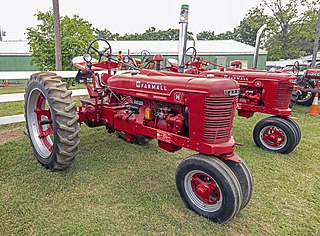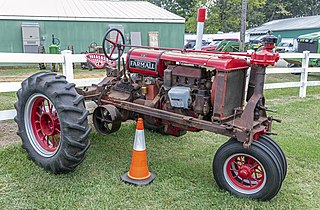
The Allis-Chalmers D series is a line of tractors made by the Allis-Chalmers Manufacturing Company from 1957 to 1969.

John Deere 3020 is a tractor that was manufactured by John Deere as part of its New Generation series from 1964 to 1972. The 3020 is nearly identical to the John Deere 3010 model that it replaced. It has a wheelbase of 90 inches, and a fuel capacity of 29 gallons. It was offered with three different engine options including a 3.7L 4-cyl gasoline engine, a 4.4L 4-cyl diesel and a 3.7L 4-cyl LP gas engine all produced by John Deere. The 3020 was rated at 71 horsepower. Transmission options included the standard Synchro Range transmission that offered 8 forward speeds and two reverse speeds and an optional eight speed power shift transmission. Several different tread options were offered by John Deere on the 3020 including, standard, narrow front Row Crop, narrow front Row Crop with "Roll-O-Matic", wide front Row Crop, Row Crop Utility. and Orchard.

The Farmall H is a medium-sized two-plow row crop tractor produced by International Harvester under the Farmall brand from 1939 to 1954. It was the most widely produced of International Harvester's "letter series", with approximately 390,000 produced over the 14-year run. It succeeded the Farmall F-20. The H was incrementally updated with new model numbers as the Super H, 300, and 350, but remained essentially the same machine. The original H used an International Harvester C152 4-cylinder in-line engine. Production of all versions lasted until 1963.

The Farmall M is a large three-plow row crop tractor produced by International Harvester under the Farmall brand from 1939 to 1953. It was of International Harvester's "letter series". It succeeded the Farmall F-30. The M was incrementally updated with new model numbers as the MD Super M, Super MD Super M-TA, but remained essentially the same machine. The original M used an International Harvester C248 4-cylinder in-line engine. Production of all versions lasted until 1954, when it was replaced by the Farmall 400 which was essentially the same machine with updated sheet metal.

The Farmall C is a small two-plow row crop tractor produced by International Harvester under the Farmall brand from 1948 to 1951. The C was developed from the Farmall B as a slightly larger, more versatile implement, raising and moving the B's offset operator seat to the centerline and increasing the wheel size to allow a straight, widely-adjustable rear axle. The C kept the International Harvester C123 engine that had been used in the Super A model. The tractor was heavier and more robust, and featured hydraulic capability from the beginning. The C was incrementally updated with new model numbers as the Super C, 200, 230 and 240, but remained essentially the same machine. The closely related successors to the C were produced until 1962.

The Farmall B is a small one-plow row crop tractor produced by International Harvester under the Farmall brand from 1939 to 1947. It was derived from the popular Farmall A, but was offered with a narrow set of centerline front wheels instead of the A's wide front axle, allowing two-row cultivation. The operator's seat was offset to the right to allow better forward visibility.

The Farmall A is a small one-plow row crop tractor produced by International Harvester under the Farmall brand from 1939 to 1947. The tractor was popular for its set of innovative features in a small, affordable implement. It succeeded the Farmall F-14. The A was incrementally updated with new model numbers as the Super A, 100, 130 and 140, but remained essentially the same machine. Like the smaller Farmall Cub, the Farmall A features a distinctive offset engine, displaced to the left over wide-set front wheels, to allow vision straight ahead. An International Harvester C113 4-cylinder in-line engine was used for early models, increased to an IH C123 with the A-1. The most significant change was the introduction of hydraulics with the Super A. The series was produced until 1973.

The McCormick-Deering W series tractors were a range of standard-tread farming and industrial tractors produced by International Harvester that were derived from the Farmall letter series row-crop tractors of the 1940s and 1950s. Branded by International Harvester as McCormick-Deering products, with the same styling and red paint as the Farmall line, the W series had fixed wheel widths, lower height and wide front axles. Starting in 1956 the W series was integrated into the International Harvester numbering series and the McCormick-Deering branding was dropped.

The Farmall F-20 is a medium-sized two-plow row crop tractor produced by International Harvester under the Farmall brand from 1932 to 1939, with approximately 148,000 produced. It replaced the Farmall Regular, and was itself replaced in 1939 by the Farmall H.

The Farmall F-12 is a small two-plow row crop tractor produced by International Harvester under the Farmall brand from 1932 to 1938, with approximately 123,000 produced. An improved model, the two-plow F-14, was produced beginning in 1938 and ending in 1939, when the Farmall letter series tractors were introduced.
The Farmall 04 series tractors are a family of row-crop tractors with four-cylinder engines, continuing the tradition of four-cylinder engines in Farmall and parent company International Harvester for general-purpose and row-crop tractors. In the early 1960s demand for more power led to the 06 series with six-cylinder engines. Four-cylinder engines were reserved for tractors equivalent to the Farmall H and smaller.

The Farmall 06 series tractors are a family of row-crop tractors with six-cylinder engines, providing greater horsepower than the parallel product line of four-cylinder Farmall 04 series tractors. Until the late 1950s, Farmall and parent company International Harvester tractors used four-cylinder engines for general-purpose and row-crop tractors. Demands for higher performance and greater horsepower led to broader use of six-cylinder engines, with the bulk of International's production moving to the larger engines. The Farmall 806 and 706 were introduced in 1963, with production running to 1967. The Farmall 1206 was introduced in 1965 as the most powerful tractor of its time, using a turbocharged diesel engine. Production of the 1206 also ran until 1967. The 06 series sold well and was regarded as extremely successful.

The John Deere Model B tractor was a two-plow row-crop tractor produced by John Deere from 1935 to 1952, with direct successors produced until 1960. The B was a scaled-down, less expensive version of the John Deere Model A. It was followed by the updated 50, 520 and 530 models.

The John Deere Model G tractor was a large three-plow row-crop tractor produced by John Deere from 1937 to 1953, with successor models produced until 1961. It was followed by the 70, 720, and 730.

The John Deere Model H tractor was a row-crop tractor produced by John Deere from 1939 to 1947.

The John Deere Model M tractor was a two-cylinder row-crop tractor produced by John Deere from 1947 to 1952, with successor models produced until 1960. It was succeeded by the updated 40, 420 and 430 models, as well as the 320 and 330 models that occupied the market positions left vacant by the more powerful 400 series models.

The John Deere Model L tractor was a small one-plow row-crop tractor produced by John Deere from 1937 to 1946.

The John Deere Model R tractor was John Deere's first diesel tractor. A large, heavy tractor, it had fixed wheel widths and was not produced as a row-crop tractor with adjustable axles. The R was followed in the John Deere numbered model series by the John Deere 80, 820 and 830 tractors, which represented evolutionary upgrades to the basic R.

The Oliver 70 series of row-crop tractors was a series of large agricultural tractors produced from 1935 to 1967 by the Oliver Farm Equipment Company. Oliver tractors were known for their powerful engines compared to competitors, and their attention to styling. The Oliver Hart-Parr 70 marked the beginning of a strikingly-styled series of tractors that were produced under both the Oliver and the Cockshutt names. Oliver's emphasis on styling strongly influenced offerings by competing brands such as Farmall and John Deere.

The Oliver 60 series of row-crop tractors was a product line of agricultural tractors produced from 1940 to 1964 by the Oliver Farm Equipment Company. The 60 series was a four-cylinder follow-on to the six-cylinder Oliver 70. As the 70 was outsold by the less-expensive Farmall A, Allis-Chalmers Model B and John Deere Model B, Oliver introduced the 60 to compete.




















